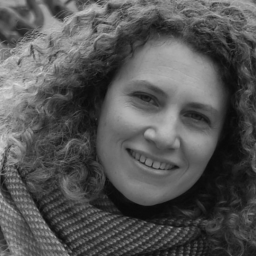Art World
Inside the Surreal Menagerie of Les Lalanne
2024 is shaping up to be the year of the husband-and-wife French duo Les Lalanne. A show just opened at New York's Kasmin gallery, and more will follow. Can their stratospheric market performance continue?
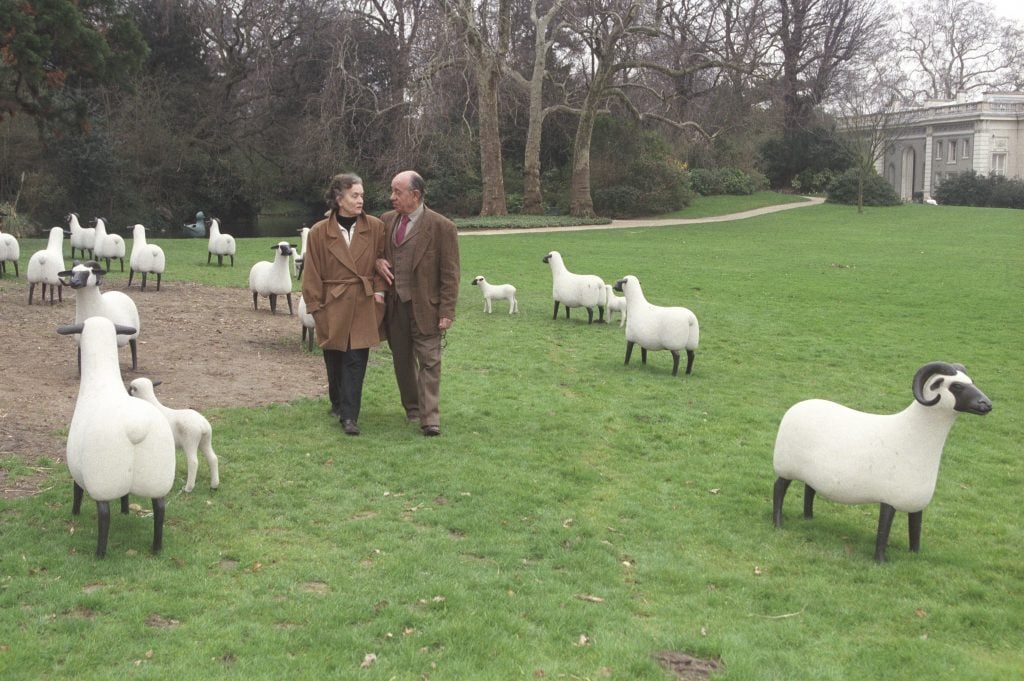
“Go ahead, sit in it,” urged Caroline Hamisky Lalanne, the eldest daughter of the late legendary French biomorphic Surrealist duo Les Lalanne. She motioned to one of her mother Claude’s functional sculptures in her Paris apartment—a chair composed of plantain lilies, their vines and leaves molded in reddish-stained, copper-electroplating and bronze. Elsewhere, beside an elegant, white couch, stood a black-patinaed, bronze ram, by her stepfather, Francois-Xavier. The ram’s neck arched against its body in a single, distilled stroke, while thin slats at its sides magically opened to reveal a bar full of liquor bottles and a pull-out tray.
A host of other Lalanne creatures roamed Hamisky Lalanne’s brightly lit Saint-Germain-des-Prés home: a life-sized, woolen black sheep that can double as a soft bench, a golden apple with human lips, and on a table, a hollow cow doubled as a vase, filled with a burst of dried hydrangeas.
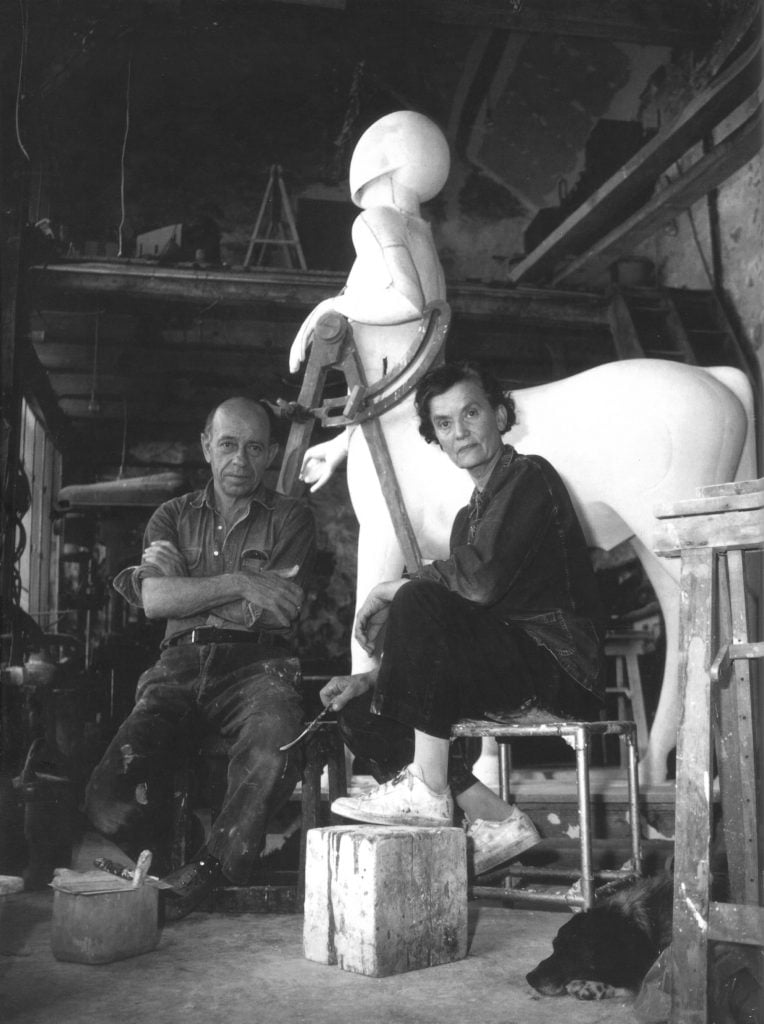
Claude and François-Xavier Lalanne in 1985. Photo: Jean-Philippe Lalanne. Courtesy of Caroline Hamisky Lalanne and Kasmin, New York.
“You see? It works,” said Caroline, 76, a spitting image of her mother, as I sat, surprisingly comfortable, on the leafy metal sculpture. “But it’s more of an object to look at, than use. Sure, it’s clearly a chair. But it’s also much more.”
That manifold raison-d’être applies to much of the surrealist dreamworld of Les Lalanne, as the artist duo called themselves individually and collectively. Working during the second half of the 20th century and early 21st century, Les Lalanne’s pun-infused, painstakingly handcrafted sculptures which are often meant to be touched, rather than kept at a lofty distance, have seduced collectors around the world. They are synonymous with a certain French chic. One that gathers avant-garde, impoverished artists together with wealthy barons around a single table of slow-cooked lamb gigot, gourmet local cheeses, and witty banter, as Les Lalanne were known to do when hosting in their country home south of Paris, in Ury.
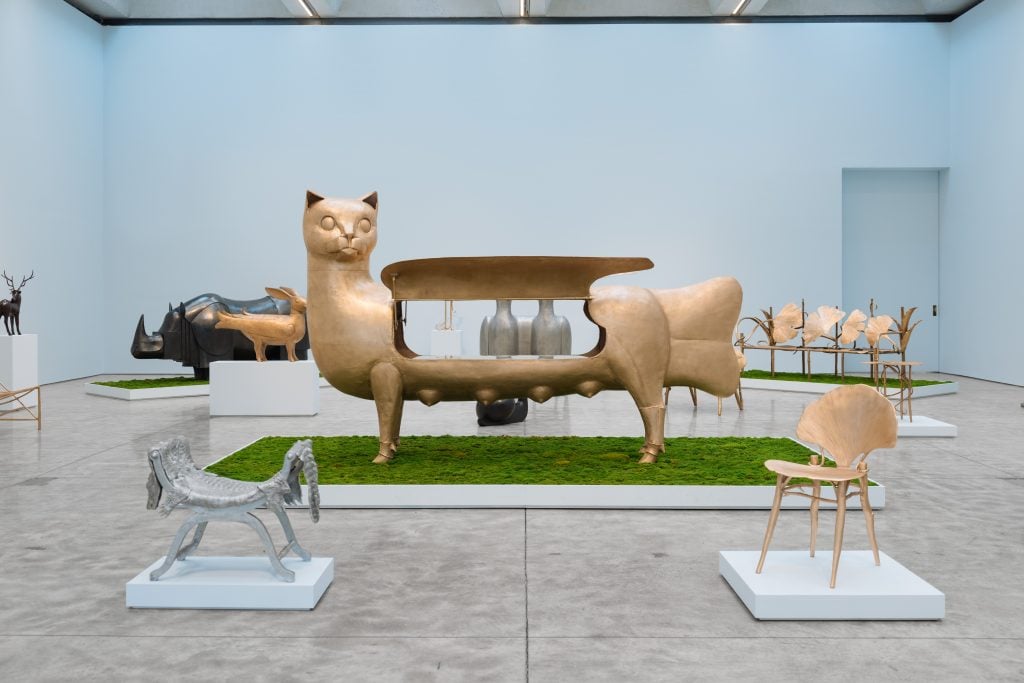
An installation view of Les Lalanne, “Zoophites,” Kasmin, New York, 2024. Courtesy of Kasmin New York.
In recent years, particularly following Claude’s death in 2019 (Francois-Xavier preceded her in 2008), when it became clear no new Les Lalanne creatures would come to life, their market also erupted. Last October, the first, massive rhinoceros desk made by François-Xavier in 1964, titled Rhinocrétaire I, sold for a record €18.3 million (about $19.8 million) at Christie’s, effectively sealing Les Lalanne as a wealth-status symbol. This year is also turning out to be particularly serendipitous for Les Lalanne, who, coupled with their on-fire market, have a slew of exhibitions planned, some of which are celebrating the 60th anniversary of their first solo exhibit as Les Lalanne in Paris.
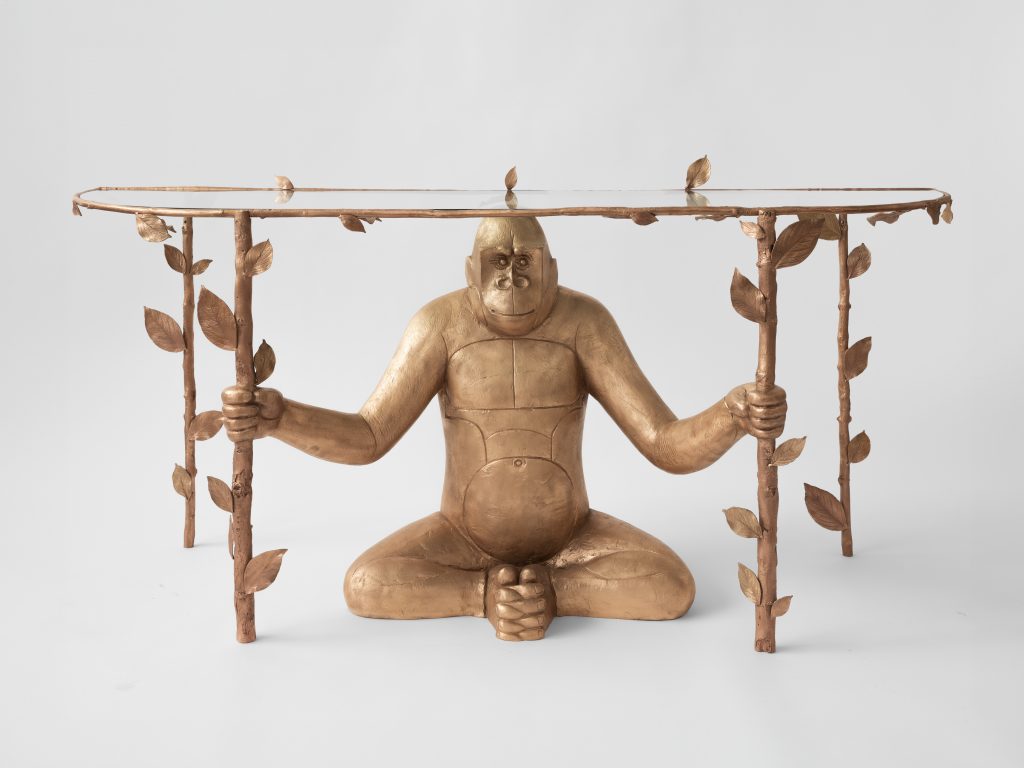
François-Xavier Lalanne, Gorille consolé, (2002/2016) © Artist Rights Society (ARS), New York, NY / ADAGP, Paris, France. Courtesy of Kasmin, New York. Photography by Charlie Rubin.
Five years after Claude’s passing, amid headlines about the artists’ spectacular performance at auctions of their other daughters’ collections— spurring a few raised eyebrows at the speed and quantity of sales—Hamisky Lalanne felt it was time to draw closer attention to what Les Lalanne’s practice is about. The result is an exhibition entirely sourced from her personal collection, “Les Lalanne: Zoophites” at Kasmin Gallery in New York. It includes some 35 pieces, as well as several monumental sculptures and is on view until May 9. The show name-checks that 1964 debut exhibit, called “Zoophite,” which is an “obsolete French term for invertebrate animals that resemble plants,” per a gallery statement. It is reused for this latest journey through the couple’s fantasy world where the outsized golden creatures gaze serenely into the distance. in their sparse surroundings, they take on a totem-like, quasi-religious air.
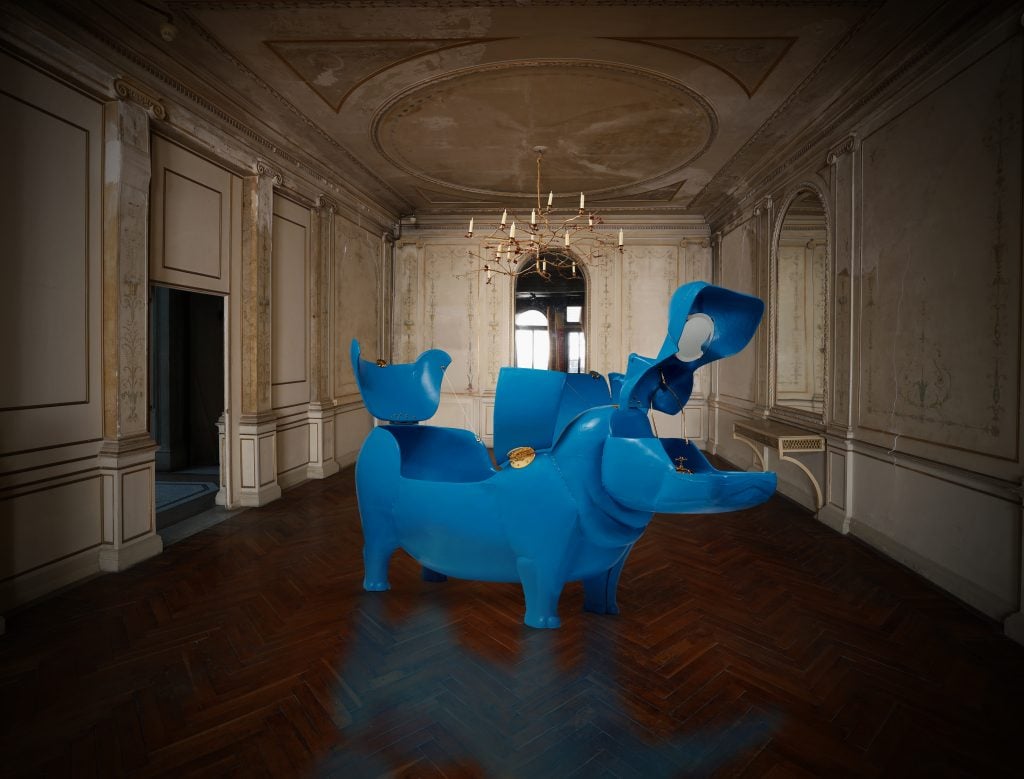
François-Xavier Lalanne, Hippopotame I, (1968/1998). “Planète Lalanne” © Courtesy of Ben Brown Fine Arts, London
The Kasmin show will be seconded by “Planète Lalanne,” a major exhibition organized by Ben Brown Fine Arts gallery at the Palazzo Rota Ivancich, Venice. Opening April 17, in time for the Biennale, the exhibit was curated by Jérôme Neutres and will feature over 150 works, “thoughtfully placed with the intent Les Lalanne imagined as “works to live with,” inviting visitors to “imagine an enchanted ‘Palazzo Lalanne,’” per the gallery’s statement. Plus, the Peter Marino Art Foundation in Southampton, New York will host “The Lalannes.” The show opens May 25 and is comprised of over 40 works from the star architect’s collection as well as life-sized photographs of “sculptures placed in-situ alongside installations of a full menagerie of enchanting works,” stated the museum.
For the Kasmin exhibit, Caroline said the gallery was a natural choice. She remembers how its late founder, Paul Kasmin, “did extraordinary things for them.” There was the game-changing outdoor exhibition he organized on Park Avenue in 2009, which helped bring the artists back onto the U.S. map, after some quieter years there. Plus, “Sheep Station” in 2013, an immensely popular exhibit Kasmin organized at a former Manhattan gas station, including an invasion of the iconic, life-sized Lalanne sheep, bringing a bit of countryside to the city, as François-Xavier liked to say.
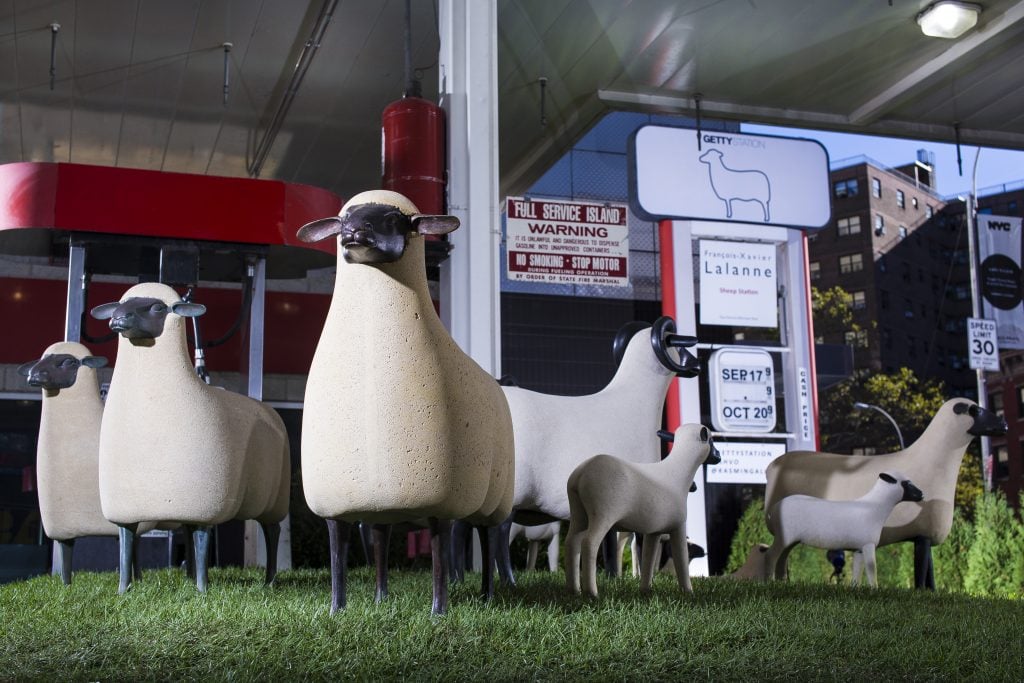
“Sheep Station.” Photo: Joshua Kogan. Courtesy of Kasmin, New York
At the April 4 Kasmin opening, a crowd of mostly collectors was easily dwarfed by massive sculptures, including an imposing, golden chimera cat titled, Grand Chat polymorphe. Displayed standing with hoofed feet atop green moss, the sides of its long, sphinxlike body were spread open like wings, revealing a large cavity. Elsewhere, cabbage leaves grew like ruffles out of a lone shoulder, in a piece by Claude, and a golden Centaure patinated bronze suggests a coded language of symbols, in one of the rare pieces both artists made together, with much difficulty, according to Caroline. The gaping tear running down the middle of the centaur’s chest would seem to reflect as much.
François-Xavier was heavily influenced by ancient Egyptian art, which he studied while working as a guard at the Louvre, and his pieces are recognized for their distilled animal forms. Though both artists exhibited together, their work differed greatly. Claude relied on a more intuitive, even messy approach, often directly molding forms from nature, while François-Xavier planned and carefully modeled his creations in advance. He also began as a painter but shifted when he and Claude were introduced to metal sculpting by their friend, the American sculptor James Metcalf, according to Caroline. Constantin Brancusi was also a significant influence, visible in his reduced, clean lines. All three of their studios shared the same bohemian enclave of artists in the 1950s, known as Impasse Ronsin, in Paris.
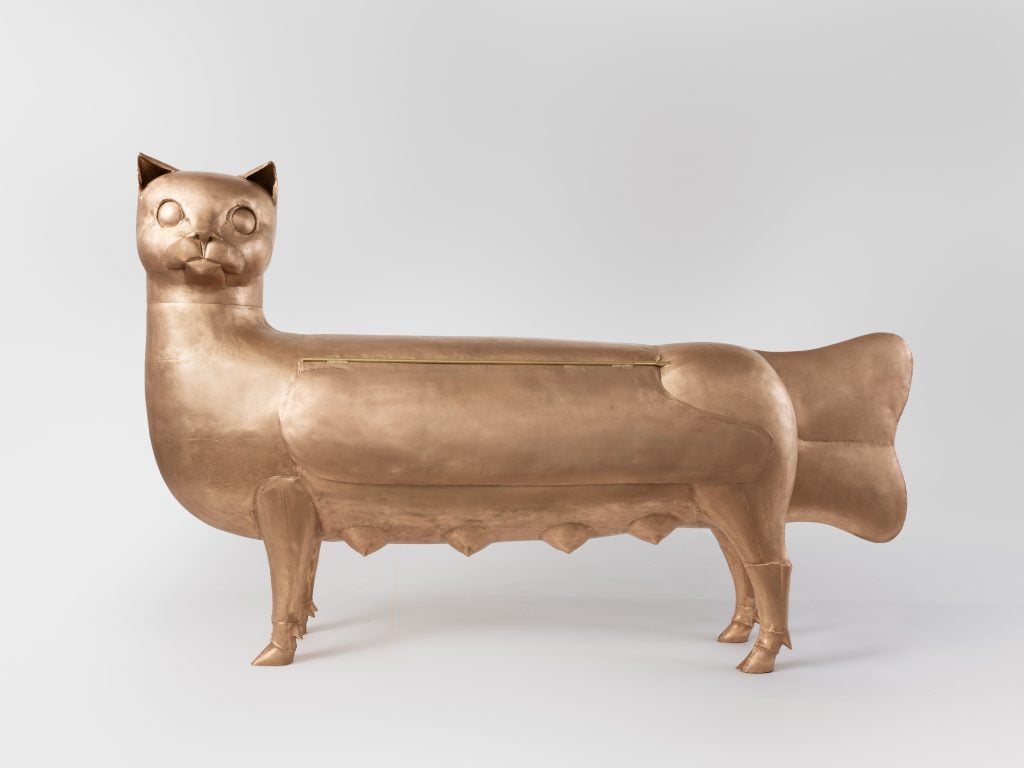
François-Xavier Lalanne, Grand Chat polymorphe, (1998/2008) © Artist Rights Society (ARS), New York, NY / ADAGP, Paris, France. Courtesy of Kasmin, New York. Photo: Charlie Rubin.
There, Les Lalanne fed off the creative energy and critical support of neighbors and friends, which also included Niki de Saint Phalle, Jean Tinguely, Max Ernst, and Eva Aeppli. But Les Lalanne’s Lewis Carroll-like creatures, some of which can be used—to varying degrees of function—as furniture, jewelry, or tableware, never did fit easily into a single artistic category, or current, such as Nouveau Réalisme, to which several of their Ronsin-alley friends belonged.
Then as now, they have maintained their outsider air, which has been both a strength and a source of anguish to the artists, when they were lumped into the design and the decorative arts: a universe they felt was too limiting, as well as inaccurate. Caroline viscerally understands the narrowness of the label, immortalized as she was by her mother, who cast sculptures of her face, as well as her pregnant body, topped with a signature cabbage head. Claude also cast bronze Choupattes, or single cabbage heads that stood on immediately droll chicken legs. Chou, means cabbage, in French, and pattes, are feet, while choupette is an endearing term. Such sculptures, like many Lalanne pieces, don’t have a purpose other than existing as art.
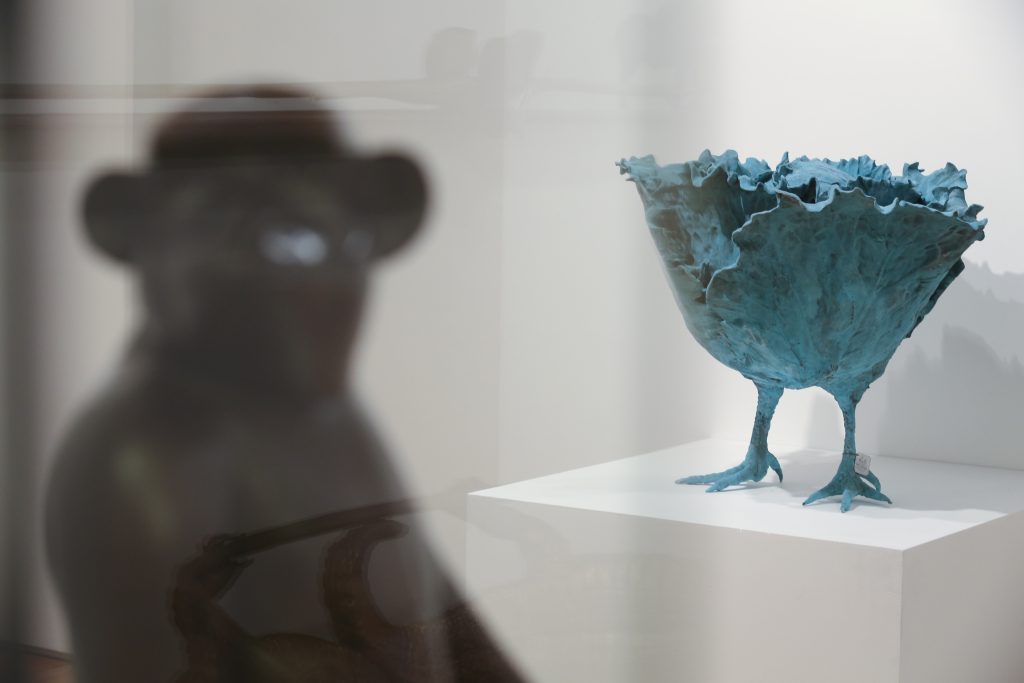
Single Avise (moyen) (2005) by Francois-Xavier Lalanne; and Choupatte (Petit) (2014) by Claude Lalanne, at Ben Brown Fine Arts, Pedder Building in Central. 14SEP16, SCMP / May Tse (Photo: May Tse/South China Morning Post via Getty Images)
“Their whole lives they fought against that label,” said Caroline, of the “Decorative Arts” mantle foisted upon her parents. “But for whatever unlucky reason, they were categorized, and once that happens, it’s very hard to free yourself from it,” she added. To a degree, that is nevertheless what she hopes to do with the Kasmin show.
Zoophites’ curator Paul B. Franklin hopes the show and his upcoming text, will poke gaping holes into the view that Les Lalanne are decorative artists or God-forbid, “designers.” Why all the confusion in the first place? “They’re doing these incredibly well-made handicrafts in the traditional historical trajectory of sculpture,” Franklin said. “Then we have the whole representational quality of their work— It’s not abstract. I think all of these little kernels of formal and iconographic aspects of their work made it hard to contain them. But that’s what is so interesting about Les Lalanne.” Rather than being made with a function in mind, Franklin points to a “parody” or “tinge” of functionality to their pieces. The idea was to make sculpture more approachable. By doing away with some of the formality and distance associated with art, they also questioned existing cultural hierarchies.
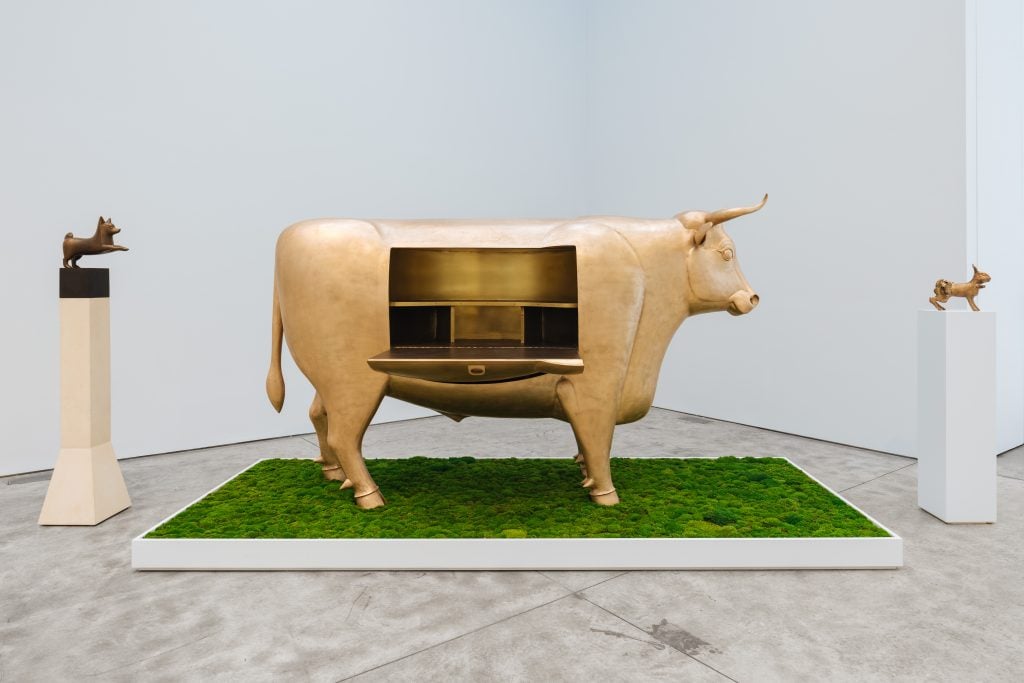
An installation view of Les Lalanne, “Zoophites,” Kasmin, New York, 2024. Courtesy of Kasmin New York.
Les Lalanne “swam against the tide, beginning in the 1960s, and were consistently misunderstood and incorrectly categorized, mostly to their detriment,” Franklin said. Today, for instance, auction houses persist in offering Lalanne works in the context of design and decorative art sales, barring some exceptions.“If we’ve learned anything in the 20th century,” he said, “we’ve learned that those categories are corrupt, and I think Les Lalanne are really lovely encapsulations of how they no longer work. Why are we still so wedded to shoehorning everyone into the same train?”
Still, that tendency doesn’t seem to hinder the loyal global collectors and major institutions who celebrate what Les Lalanne make. For that matter, the dealer Jean-Gabriel Mitterrand explains Les Lalanne became famous thanks to a star-studded list of French collectors, including Yves Saint Laurent and Pierre Bergé, Gunter Sachs, Karl Lagerfeld, and Baron Guy and Baroness Marie-Hélène de Rothschilds. Many of them learned about Les Lalanne from one man, the surrealist gallerist Alexandre Iolas, and before him, the influential critic Pierre Restany and Jeanine Goldschmidt, who first showed Les Lalanne as a collective in the 1964 show at Galerie J in Paris, which took place two years after they were married.
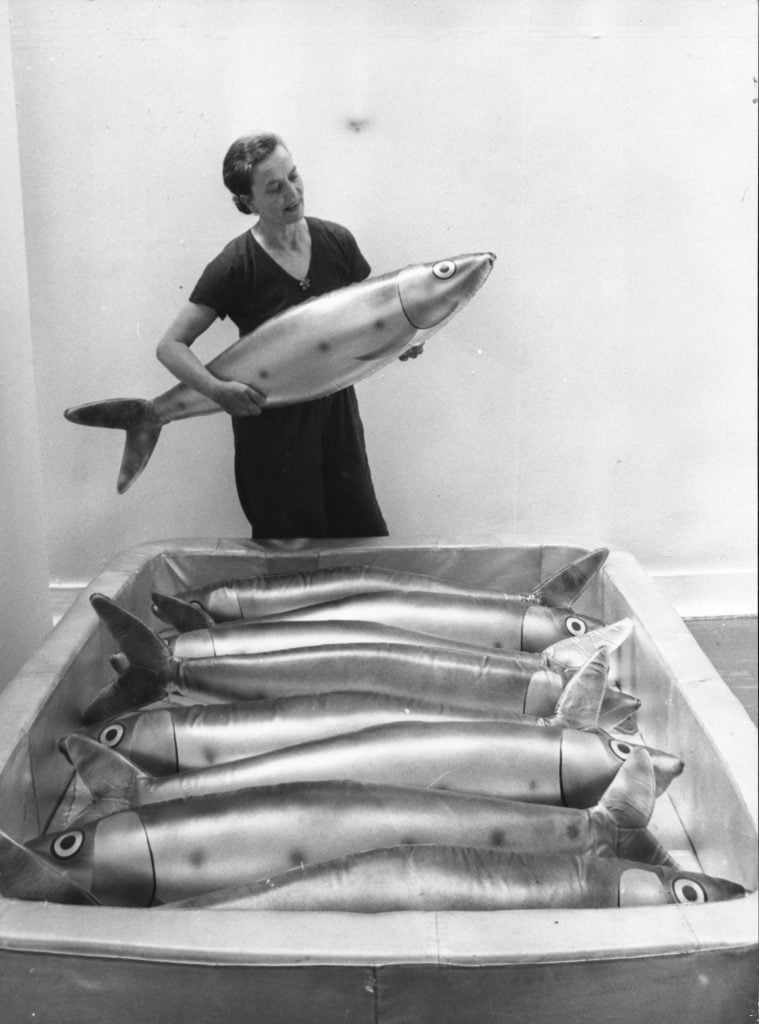
Claude places another giant sardine into the tin, as she and her husband Francois-Xavier Lalanne prepare their sculpture exhibits for an exhibition at the Whitechapel Art Gallery, in East London. (Photo: Chris Ware/Getty Images)
Perhaps more importantly, Les Lalanne were first introduced to both dealers by their friends, the artists on Impasse Ronsin. Prior to that, and with four children between them [Claude had three children and François-Xavier had a child when they met in 1953]. earlier in their nascent relationship they tried and failed at earning a living by designing windows for luxury brands like Dior, even working alongside a young Yves Saint Laurent. Yet they soon realized it was a financially unsustainable endeavor, remembers Caroline. Her mother had to borrow money to pay the bills.
A turning point came when “Jimmy [Metcalf] told them, ‘you need to become artists,’ and he introduced them to Jeanine Goldschmidt,” said Caroline. Then they met Iolas through Saint Phalle, and from there things began to take off.
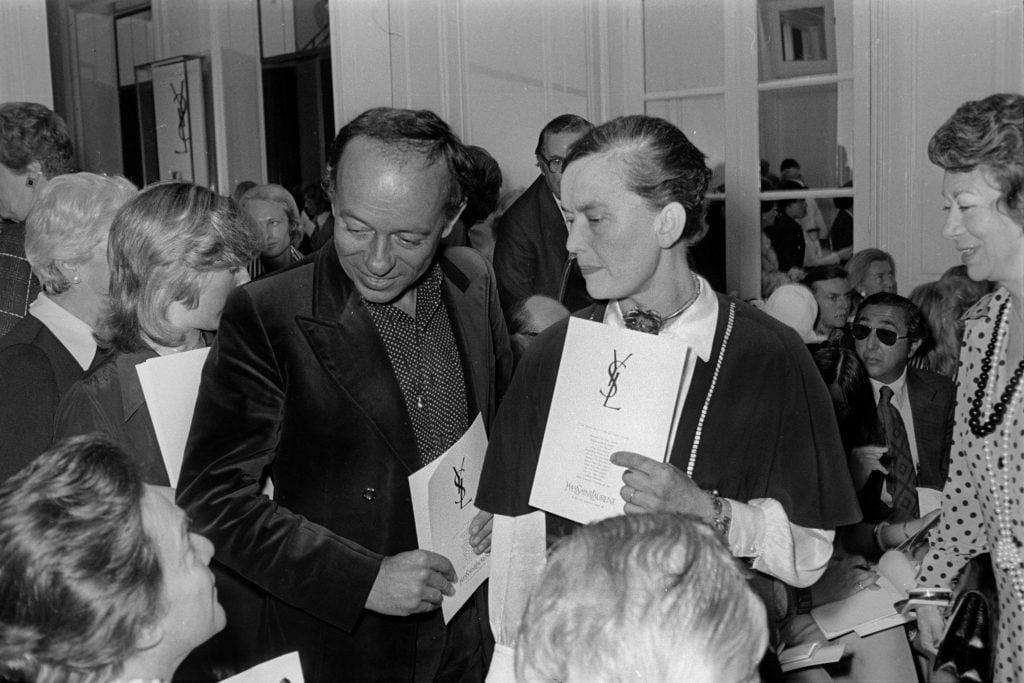
Francois-Xavier and Claude Lalanne attend the Yves St. Laurent fall 1972 Couture collection on July 28, 1972 in Paris, France. (Photo by Fairchild Archive/Penske Media via Getty Images)
Saint Phalle, whom Caroline remembers as “extravagant and funny,” when she worked as her assistant, before doing the same for Claude, had all but predicted it. “Niki told my mother, ‘You’ll see, the day it catches on, it won’t stop.’”
As they became more successful in France, Les Lalanne crossed the Atlantic, and rubbed shoulders with Andy Warhol and the New York avant-garde scene, where they were championed by the collector Jane Holzer, and eventually the architect and designer Peter Marino. The latter, who has a namesake art foundation in Southampton, New York, also curated Les Lalanne’s hit retrospective at Paris’ Musée des Arts Décoratifs in 2010 (Claude was more open to the idea of exhibiting in a decorative arts context). Another major moment in Les Lalanne’s visibility, came in 2021, with an exhibition organized with the Galerie Mitterrand at Chateau de Versailles, in the lush gardens around the former French queen’s favorite castle hideaway, the Petit Trianon and the Queen’s Hamlet. Today, they can be found in public collections from the Centre Pompidou and Windsor Castle, to the Heidi Horten Collection in Vienna, and the Cooper-Heweitt Museum, New York.
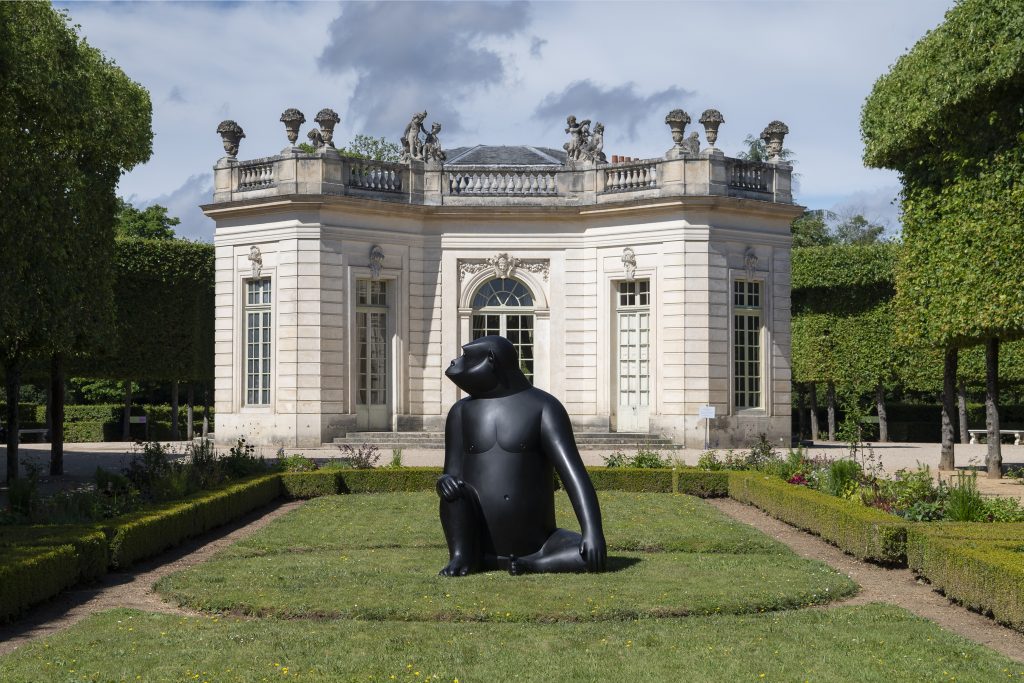
Francois Xavier Lalanne, Singe avisé, (2005). Exhibition at Chateau de Versailles “Les Lalanne à Trianon” on June 18, 2021 in Versailles, France. Photo: Luc Castel/GettyImages)
True to Saint Phalle’s word, Les Lalanne’s global collector base continues to expand at a healthy pace, alongside prices, say dealers. “Every time we have an exhibition, we find new clients. It’s unbelievable,” said Edith Dicconson, executive director of New York’s Kasmin Gallery, which has represented Les Lalanne in the U.S. since 2007. “They hit you right in the heart, and the work has something innocent to it that speaks to a wide berth of people. At our last exhibition I sold to all new clients,” she said. “It’s kind of what you want.”
Some of that newer interest is linked to their high-generating auction prices, which have multiplied fabulously in the last decade. An important jump came after Christie’s auctioned the collection of designer Yves Saint Laurent and his partner, Pierre Bergé, which included two Lalanne pieces, the Bar ‘YSL’ (1965) by François-Xavier, which sold for €2.8 million (about $3 million), and Claude’s Salon des Miroirs (1975 – 85), which sold for €1.9 million (about $2 million).
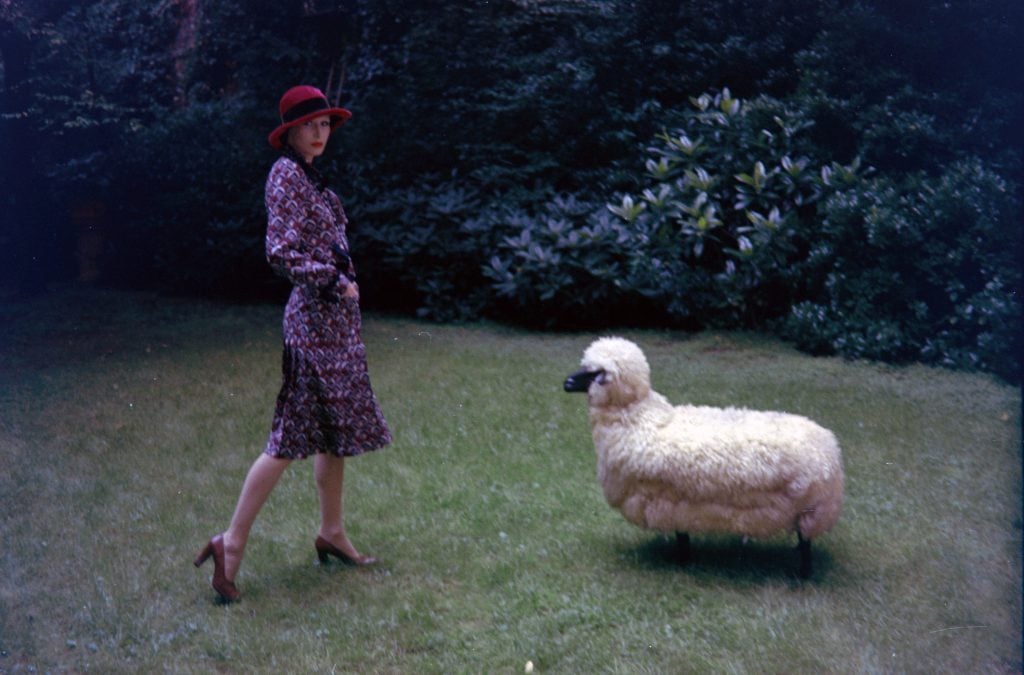
A model poses in look from YSL’s Fall 2972 RTW collection with a Claude Lalanne sheep chair at the designers Paris apartment. (Photo by Fairchild Archive/WWD/Penske Media via Getty Images)
However, it wasn’t until 2019 that, “all at once we realized the record prices that Les Lalanne could reach. We had noticed it a little before, but then it took real shape,” said Mitterrand, who has had a relationship with Les Lalanne since the 1970’s. That 2019 sale at Sotheby’s Paris broke the auction house’s records, fetching $101.5 million. Another at Christie’s in December 2022 brought in over $77 million.
Since 2019, Claude has become one of the world’s top-selling female sculptors in terms of auction prices, according to Dicconson, though her record is a comparatively lower €4.97 million ($5.38), fetched for the “Tres grand choupatte,” versus François-Xavier’s $19.8 million rhino.
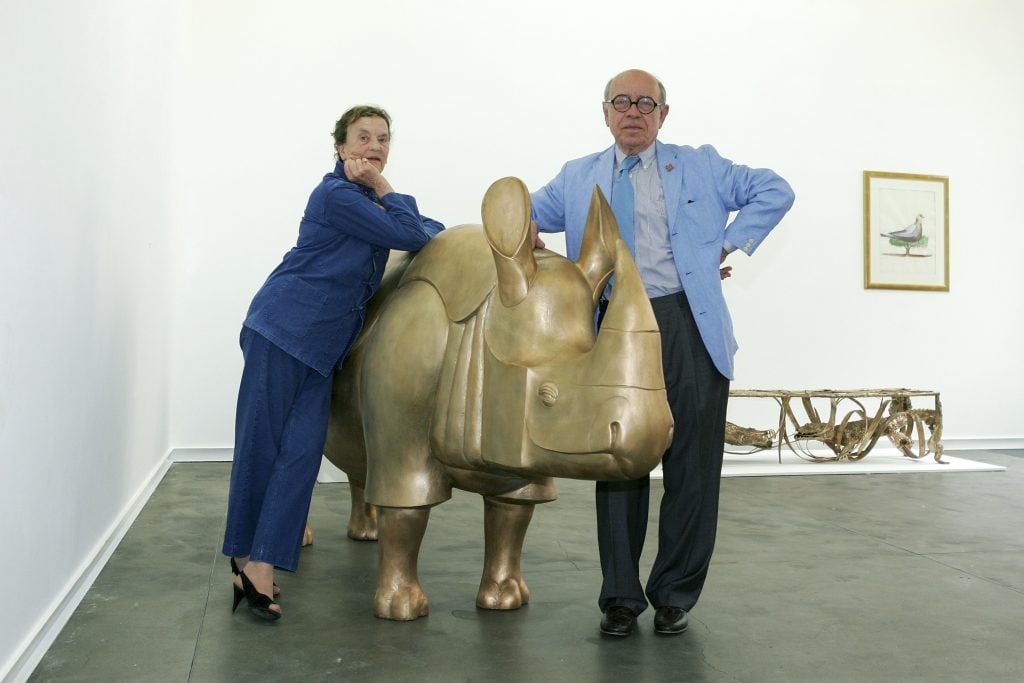
Claude Lalanne and Francois-Xavier Lalanne attend the Opening of their exhibition at Mitterrand Gallery on May 25, 2005 in Paris, France. (Photo: Luc Castel/GettyImages)
Nevertheless, Mitterrand cautioned against the risks of successive, multiple auctions. “We think that this mass of works thrown onto the market so quickly is double-edged,” he said. On the positive side, auction houses have invested significantly into “defending” Les Lalanne, with extensive catalogs, and show “a confidence in the quality and importance of the pieces on the market,” he said. However, “at the same time, it’s evident that an avalanche of artworks [for sale] is very dangerous because we can of course imagine that the market could weaken.”
Still, those concerns have not shaken his faith in how things are going. “The value of all Lalanne oeuvres has continuously strengthened, thanks to these record prices, which are pulling everything upwards,” he said.
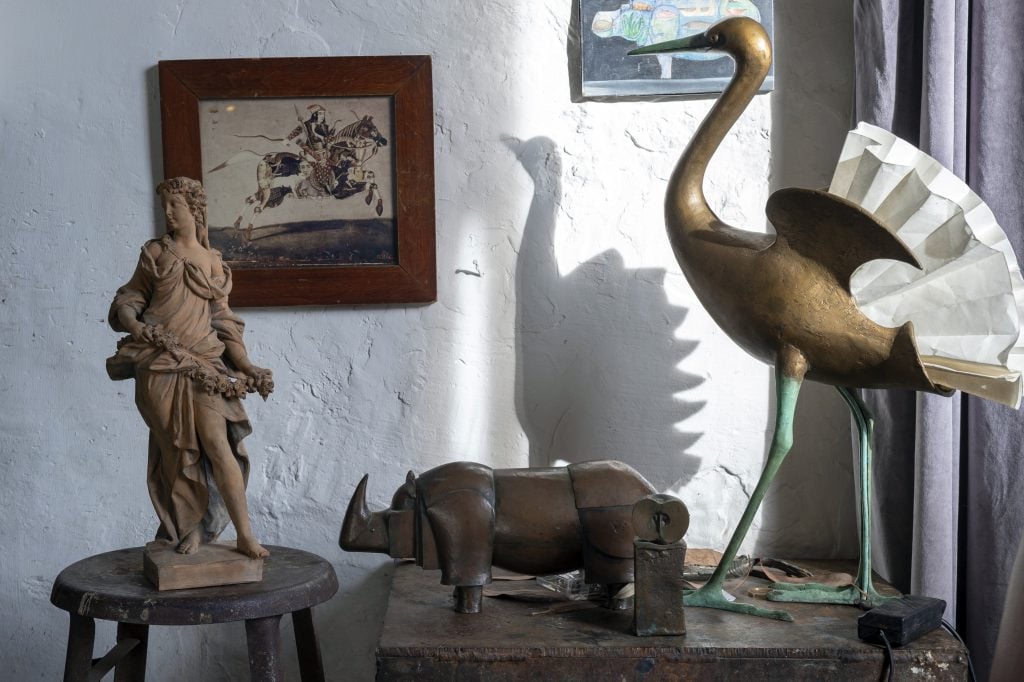
General view of French artist Claude Lalannes’ atelier on December 15, 2015 in Ury, France. (Photo: Luc Castel/Getty Images)
In fact, Les Lalanne has a few key advantages up their sleeve, which keep collectors coming. “Sculpture is always a bit of a space problem for collectors. But when the sculpture has a certain function, it positions itself in the home as” other furniture would, said Sébastien Carvalho, director at Galerie Mitterrand. “[The artists] found a solution to that problem of using space … to date, no one else has done that.”
Another market-reassuring aspect to the work, is its diversity. Both artists worked so differently, making an eclectic range, from life-sized hippo bathtubs by François-Xavier to fingers poking out of snail shells by Claude. This “leaves a lot of opportunities for the acquisition of different works, which mitigates the fact that there are a lot of [Lalanne] objects on the market,” said Mitterrand.
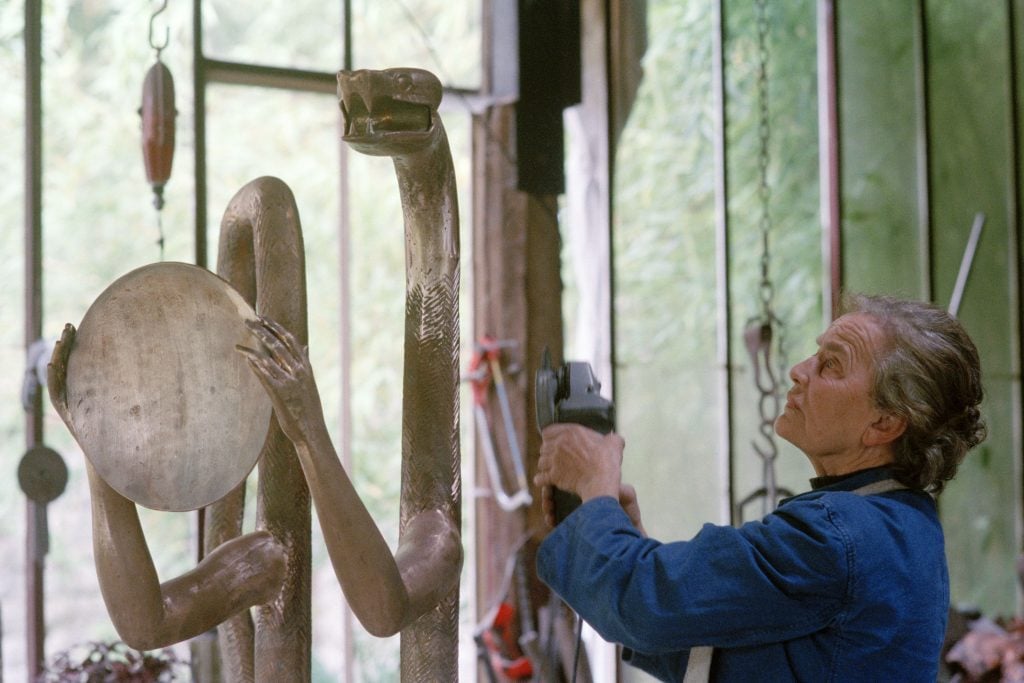
French sculptor Claude Lalanne in her workshop, at home in Ury. (Photo by Catherine Panchout/Sygma via Getty Images)
About those differences, Les Lalanne also broke with convention by sharing a single, artistic moniker, despite working separately, barring rare collaborations. This leveling of the playing field as a professional couple, however, did not prevent François-Xavier from receiving the lion’s share of attention, according to Franklin. He generally spoke during interviews, despite Claude being the “dynamic” driving force in their relentless work rhythm, Franklin notes.
After François-Xavier’s death, Claude stepped more boldly into the spotlight and continued working late into her life, with the assistance of Caroline’s daughter, Julie Hamisky—a sculptor who learned the trade from her grandmother—and her husband, Darius Metcalf, son of Les Lelanne’s friend, James Metcalf.
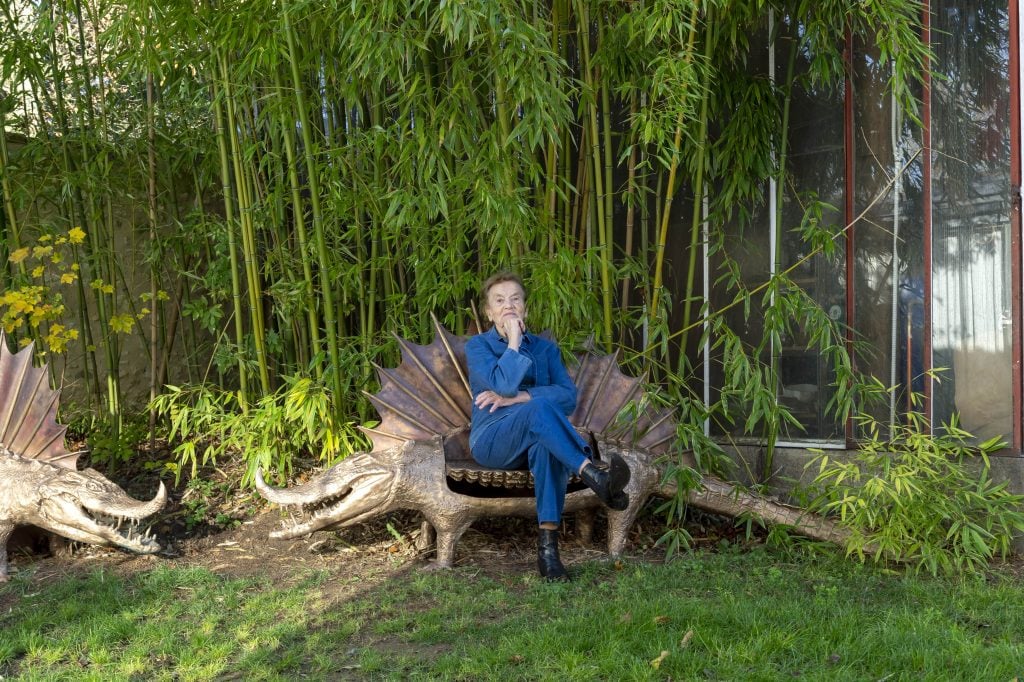
French artist Claude Lalanne works in her atelier on December 15, 2015 in Ury, France. (Photo: Luc Castel/Getty Images)
“What I hope will come out of this exhibition, is that we can no longer allow François-Xavier to cast such a large shadow over Claude’s work,” said Franklin, about the Kasmin show. Her “work is incredibly complicated and fantastically brooding,” he said. She also upped the size of her work from smaller objects and jewelry, after the couple moved south of Paris, to their larger space in Ury.
By the late 60’s, explains Franklin, “She bursts out and starts working on a much larger scale. From there, she begins to sing.”

